Related Research Articles
Handloading, or reloading, is the practice of making firearm cartridges by manually assembling the individual components, rather than purchasing mass-assembled, factory-loaded commercial ammunition.

A cartridge, also known as a round, is a type of pre-assembled firearm ammunition packaging a projectile, a propellant substance and an ignition device (primer) within a metallic, paper, or plastic case that is precisely made to fit within the barrel chamber of a breechloading gun, for convenient transportation and handling during shooting. Although in popular usage the term "bullet" is often used to refer to a complete cartridge, the correct usage only refers to the projectile.

The .223 Remington is a rimless, bottlenecked, centerfire intermediate cartridge. It was developed in 1957 by Remington Arms and Fairchild Industries for the U.S. Continental Army Command of the United States Army as part of a project to create a small-caliber, high-velocity firearm. The .223 Remington is considered one of the most popular common-use cartridges and is currently used by a wide range of semi-automatic and manual-action rifles.

The .308 Winchester is a smokeless powder rimless bottlenecked rifle cartridge widely used for hunting, target shooting, police, military, and personal protection applications globally. It is similar, but not identical, to the 7.62×51mm NATO cartridge.

A wildcat cartridge, often shortened to wildcat, is a custom cartridge for which ammunition and/or firearms are not mass-produced. These cartridges are often created in order to optimize a certain performance characteristic of an existing commercial cartridge, or may merely be intended as novelty items.
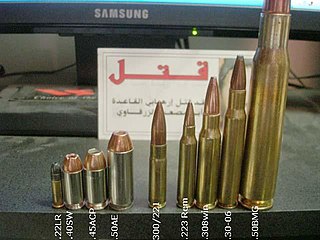
The .300 Whisper (7.82x34mm) is a CIP standard cartridge in the Whisper family, a group of cartridges developed in the early 1990s by J.D. Jones of SSK Industries. It was developed as a multi-purpose cartridge, capable of utilizing relatively lightweight bullets at supersonic velocities as well as heavier bullets at subsonic velocities.
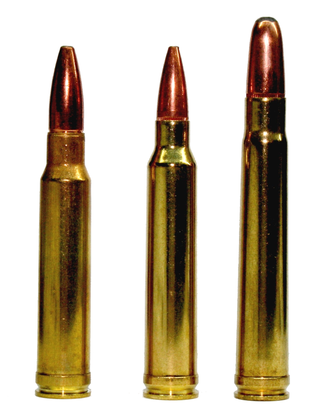
The .300 Winchester Magnum is a belted, bottlenecked magnum rifle cartridge that was introduced by the Winchester Repeating Arms Company in 1963. The .300 Winchester Magnum is a magnum cartridge designed to fit in a standard rifle action. It is based on the .375 H&H Magnum, which has been blown out, shortened, and necked down to accept a .30 caliber (7.62 mm) bullet.
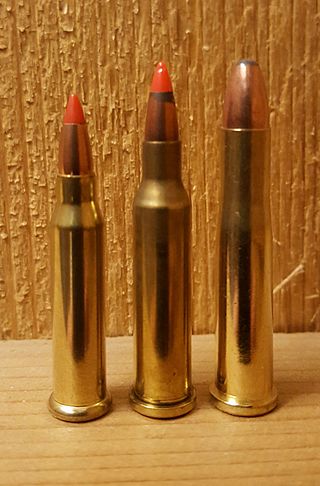
The .17 Hornet is a .17 caliber centerfire rifle cartridge originally offered as a "wildcat cartridge" developed by P.O. Ackley in the early 1950s. He created this non-factory (wildcat) offering by simply necking-down the .22 Hornet to .17 caliber and fire-forming the resized cases in his new chamber design. The result was a small quiet cartridge capable of high velocity. Ackley mentions it as one of the most balanced of the .17 cartridges of his time; likely, this is still true.
The .260 Remington cartridge was introduced by Remington in 1997. Many wildcat cartridges based on the .308 Winchester case had existed for years before Remington standardized this round.

The .416 Remington Magnum is a .416 caliber (10.57 mm) cartridge of belted bottlenecked design. The cartridge was intended as a dangerous game hunting cartridge and released to the public in 1989. The cartridge uses the case of the 8 mm Remington Magnum as a parent cartridge. When the cartridge was released in 1988, author Frank C. Barnes considered the .416 Remington Magnum to be the "most outstanding factory cartridge introduced in decades".

The .450 Bushmaster (11.48x43mmRB) is a rifle cartridge developed by Tim LeGendre of LeMag Firearms, and licensed to Bushmaster Firearms International. The .450 Bushmaster is designed to be used in standard M16s and AR-15s, using modified magazines and upper receiver assemblies.
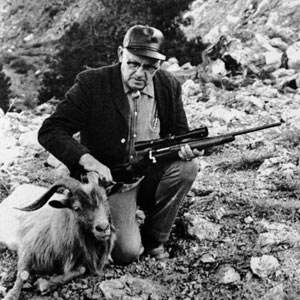
Parker Otto Ackley was an American gunsmith, barrel maker, author, columnist, and wildcat cartridge developer. The Ackley Improved family of wildcat cartridges are designed to be easily made by rechambering existing firearms, and fireforming the ammunition to decrease body taper and increase shoulder angle, resulting in a higher case capacity. Ackley improved not only standard cartridges, but also other popular wildcats, and was the first to create a .17 caliber (4.5 mm) centerfire cartridge.
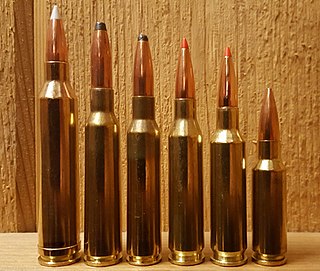
The 6.5mm Creedmoor (6.5×48mm), designated 6.5 Creedmoor by SAAMI, 6,5 Creedmoor by the C.I.P. or 6.5 CM or 6.5 CRDMR for short, is a centerfire rifle cartridge introduced by Hornady in 2007. It was developed by Hornady senior ballistics scientist Dave Emary in partnership with Dennis DeMille, the vice-president of product development at Creedmoor Sports, hence the name. The cartridge is a necked-down modification of the .30 Thompson Center.
The 6×45mm is a rimless, bottlenecked cartridge based on the .223 Remington or 5.56 NATO cartridge necked up to .243 (6mm). The cartridge is also known as the 6mm-223 Remington or 6mm/223.
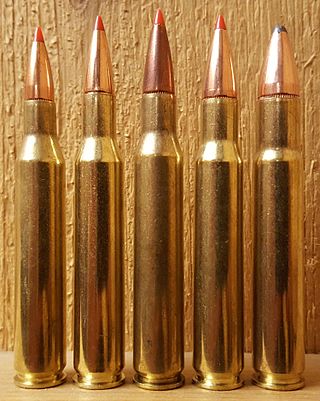
.30-06 Springfield wildcat cartridges are cartridges developed from a 30-06 Springfield "parent cartridge" through narrowing or widening the cartridge neck to fit a smaller or larger bullet in an attempt to improve performance in specific areas. Such wildcat cartridges are not standardized with recognized small arms standardization bodies like the SAAMI and the CIP.
The .277 Wolverine (6.8x39mm) is a wildcat cartridge. It is a multi-purpose mid-power cartridge with increased ballistic performance over the AR-15's traditional .223 Remington cartridge. The use of a modified 5.56 case means that at minimum, only a new barrel is needed to convert any 5.56-based firearm to .277 Wolverine.
Nosler produces six different rebated rim hunting cartridges. The first to be introduced was .26 Nosler, followed by .28 Nosler, .30 Nosler, .33 Nosler, .22 Nosler, and .27 Nosler.

The .350 Legend, also called 350 LGND (9×43mmRB), is a SAAMI-standardized straight-walled intermediate rifle cartridge developed by Winchester Repeating Arms. The cartridge was designed for use in American states that have specific regulations for deer hunting with straight-walled centerfire cartridges. At the cartridge's introduction, Winchester claimed that the .350 Legend was the fastest production straight-walled hunting cartridge in the world, although some .450 Bushmaster .444 Marlin and .458 Winchester Magnum loads are faster and have much more energy, and the .350 Legend would be surpassed in 2023 by the .360 Buckhammer. It is designed for deer hunting out to a maximum effective range of 250 yards (230 m).

The 6mm Advanced Rifle Cartridge (6×38mm), or 6mm ARC for short, is a 6 mm (.243) caliber intermediate rifle cartridge introduced by Hornady in 2020, as a low-recoil, high-accuracy long-range cartridge, designed for use in the AR-15 platform at request of a specialized group within the U.S. DoD for its multipurpose combat rifle program.
References
- ↑ Barnes, Frank C.; Holt Bodinson; Layne Simpson (2009). Cartridges of the World: A Complete and Illustrated Reference for Over 1500 Cartridges (12 ed.). Gun Digest Books. p. 157. ISBN 978-0-89689-936-0.
- 1 2 James, Rodney (2011). The ABCs of Reloading: The Definitive Guide for Novice to Expert (9 ed.). Krause Publications. p. 127. ISBN 978-1-4402-1396-0.